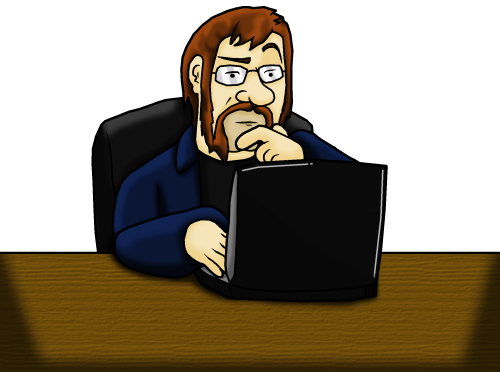Game Guides for Non-Gamers: Shadow of the Colossus
Shadow of the Colossus is the video game representation of the classic fantasy archetype – a hero fights and slays a huge monstrous beast.
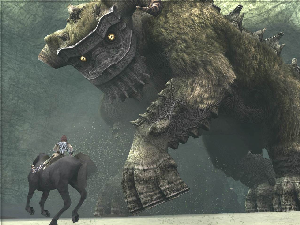 No guns in this one, then?
No guns in this one, then?
No, you’re not playing as an assassin or a secret agent, you’re just some have-a-go-hero out to save a damsel. In this case, saving the damsel means having to find, fight and defeat sixteen huge behemoths. It’s David versus Goliath, except Goliath has brought all his mates along.
I’ll be honest, this game’s probably in my top ten all-time greatest, if ever I made a list.
What’s it really about then?
There’s very little dialogue in this game, and what little dialogue gets spoken is actually in a nonsensical fictional language that’s subtitled. It lets actions do the talking, but it’s quite straightforward.
A traveller on horseback goes a long distance to arrive at a huge tower via a long aqueduct-like bridge. Entering the tower, he finds an altar and lays an unconscious maiden along it. A booming, disembodied voice from above recognises the sword the traveller holds, and bargains that it (the mysterious godlike entity) can revive the maiden should the traveller locate and defeat 16 colossi, each represented by a large statue inside the tower’s main hallway.
From there, you are left to control the traveller (named “Wander” in the manual and never in the game itself), seek out the colossi using the sword’s magical light-pointer and defeat them by stabbing the glowing marks on their bodies (again, revealed by the sword1).
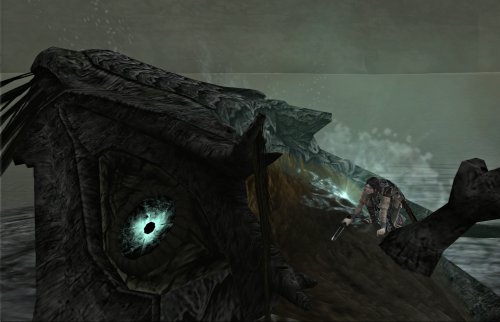
Sounds pretty straightforward.
I have to say, this is a beautiful game. It might be considered weird to see something like a video game described in such a manner, but the “Forbidden Lands” that Wander has to traverse are fantastically stunning. Which is good, because it’s a very lonely game about travelling vast, unpopulated areas with only your horse for company.
In many ways, this is a little bit like a sandbox game-
-Wait, what’s a sandbox game?
You’ve heard of Grand Theft Auto, right? The infamous game that corrupts youth by allowing them to kill prostitutes and steal cars (sometimes at the same time)? That’s a sandbox game. It refers to an open environment where the player is allowed to do whatever they want, within reason.
Anyway, Shadow of the Colossus is a sandbox game insofar that you are left to navigate the world yourself, but I would say that the analogy would be that if SotC was a sandbox it would be one with lots of pretty multicoloured sand and that’s about it2.
There’s lots of travelling, and part of the charm is feeling that the lands you are traversing are huge. It’s a marvellous little trick as the whole of the Forbidden Lands can actually be traversed from one side to the other in about ten to fifteen minutes, but the map provided is obscured by clouds which are removed as you defeat colossi. The sheer emptiness really does make you feel alone against the world.
You quickly become attached to your indispensable but cumbersome horse, which always feels a little bit too slow to traverse the land with and isn’t the easiest beast to control; it bucks if you verge too close to a ridge that’s a little bit too high and often gets caught up on scenery. Sometimes it gets distracted and walks off, meaning you have to call out to it. It’s awkward to climb on the horse3, which is annoying when you’re fighting a colossus that’s bearing down on you. Despite all these flaws, as your only companion during the game you still become fond of it. Calling out to it reveals that its name is “Argo”, but in my case I’d often affectionately call it “Aggro” because of the sheer amount of aggravation it caused me (it kept giving me “aggro”!).
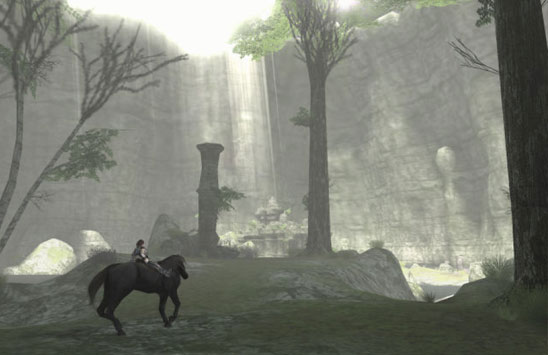
Enough about the horse! What about these colossuses…colossi? Like all video games, it’s all still about killing, isn’t it? And what’s so important about their shadow?
You know, I’ve never worked out why it’s called “Shadow of the Colossus”. I guess it might be in reference to the fact that they are all so big that you’re usually stood in their shadow?
As for your remark about the killing – sure, you are killing these huge creatures, but they don’t make it easy for you. Have you ever heard of a “boss fight”? You must have! In video games, you deal with smaller common enemies and then at some point you encounter a big enemy, usually the “boss” of the other, smaller enemies. A good example would be the badnik robots in Sonic the Hedgehog and their boss, Dr. Robotnik (incidentally I particularly like Dr. Robotnik, which is why I once wrote a massive article devoted to the many evil creations of Dr. Robotnik).
The colossi are each a boss fight in themselves. Every single one is big enough to crush you into human paste, and you have to take a different strategy in finding the weak spot on every creature. Some have to be tricked into revealing a weak spot, some have to be tripped up, and some of them are just cases of taking the bull by the horns and leaping on to the behemoth and getting on with it. Your magic sword reveals weak spots on each creature – in most cases, they are on the head but sometimes there’s a secondary one secreted somewhere less obvious.
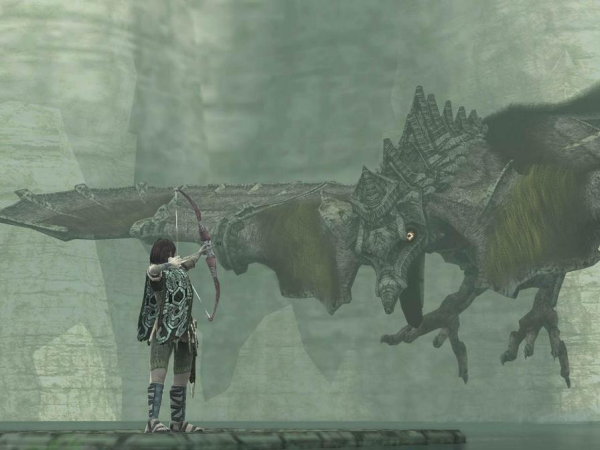
Rather than being a game of straight-up killing things, SotC is closer to being an abstract puzzle game. Each colossus is like a big statue covered in grass, so it’s like navigating across a chunk of moving scenery and figuring out how to reveal or reach the weak spots on each creature. On the first run through, you might spend two or three hours on one colossi just trying to figure it out (and sometimes the disembodied voice of god will try and drop a hint to help you).
Once you’ve played the game, it encourages you to use your new-found knowledge to defeat each creature within a time limit. Doing so unlocks new weapons and helpful items like masks of strength, cloak of invisibility, explosive arrows, etc.
That’s about it.
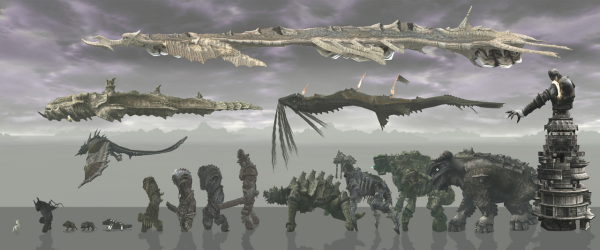
So…that’s it?
Well…I’d like to talk about the game in more detail, but I don’t want to spoil it. So I’ll hide the next bit with black, just highlight it to read. Spoilers ahoy, be warned!
There’s a mighty neat twist in the game. Throughout the game you begin to suspect that something is amiss with what’s going on. A lot of the colossi don’t immediately attack you – in fact, quite a few of them are sedate and minding their own business. A lot of the attacks come in the form of self-defence. It’s very noticeable on a lot of the creatures that they are scared when you attack their weak points, shaking harder to dislodge you or, in some cases, running away! That’s not how evil creatures usually behave.
A further odd note is what happens when you kill a colossi. They collapse in defeat, and long black transparent strings burst from them. It’s surprising on the first kill, as these strings quickly enter into Wander, knocking him unconscious. Every time, he awakens in the tower. On subsequent kills, no matter how far away you try to run, the shadowy strings will always find you and enter you.
Around halfway through, it becomes apparent that the killing of the colossi is taking its toll on Wander. He becomes more shabby, his clothes frayed. His face dirties, and in the last third of the game his bright red hair has turned black and dark lines run across his face. Something is definitely wrong with Wander.
Meanwhile, a group of soldiers accompanied by an old mage in mask and robe are travelling on horseback in pursuit of Wander. It’s only after the final sixteenth colossi is defeated that all becomes clear – the pursuing group arrives at the tower just in time to see all the evil inside Wander take over. It becomes clear that the disembodied voice is that of an evil entity called Dormin, who has been using Wander the entire time. Wander turns into a colossus of shadow, and the old mage and his band of soldiers make their escape as a banishing spell consumes Wander and destroys the bridge to the tower, the only way into the Forbidden Lands.
Basically, you are the villain. The old mage remarks that the sword Wander is holding is one he stole, and you realise that what you’ve been doing is releasing the evil of Dormin, trapped in the guardians of the colossi. The glowing points on their bodies were magical seals, and every time you stabbed them evil blackness would fire out in spurts. Truth be told, the blackness is probably where the title actually comes from – you are releasing the shadows of the colossi.
The ending is a tragedy on par with Romeo and Juliet. Before leaving the Forbidden Lands for good, the old mage remarks that Wander may one day “atone for his sins”. After all the commotion with Wander’s transformation, his beloved maiden finally wakes up. She’s approached by Argo, Wander’s faithful horse who, before the last colossi, took a fatal tumble off of a cliff and bucks Wander to safety in one of the most heartbreaking sequences in any video game ever. Argo’s leg is broken, but he leads the maiden to the back of the tower’s main hall, where they find a baby lying there. It has Wander’s red hair, and horns. Presumably he has been regressed to this state as a “last chance”.
The horse then heroically (remember, Argo has a broken leg) leads the maiden (and the baby in her arms) to the top of the tower where they discover wildlife living carefree in a scene straight out of Bambi – the implication is that they will be safe up there and will be able to live comfortably. It’s tragic, given that Wander undertook his nefarious deeds in order to be reacquainted with the maiden he presumably loved. Her life was in his hands and now, reduced to infancy, his life is now in hers. You can only assume that Argo didn’t have long left after the game ends, given his broken leg.
There are little hints throughout the game too that Dormin is slowly building his power inside Wander – every time you defeat a colossus your strength and life increase slightly. Similarly, every time you eat fruit or the cursed black lizards with glowing tails in the land (the two scavenger hunts in the game) your strength and life bar increase. However, eating the fruit at the top of the shrine tower (something you can only do by climbing it, which in turn you need superhuman strength for) reduces your life and strength back to what they were at the start of the game. A lot of people assume this fruit is poisoned – not so! Thinking it through, the fruit at the top of the tower is blessed, and it removes the superhuman attributes given to Wander by the consumption of evil from the colossi or from the “forbidden fruit” of the Forbidden Lands.
The baby Wander has two tiny horns growing from its head. Apparently this infers that he’s a grandfather of the kid from Ico, which is another lauded game I still haven’t had chance to play at the time of writing this.
Wow, that’s something. If I wanted to play this, where would I start?
Either you’ll need a PS2 and then track down an old PS2 copy, or if you’ve got a PS3 you can buy the HD re-release which comes with the game Ico (the first game in the “series”, if you will). If you’re on Xbox, tough noogies! Try a better console.
I hope this article has prompted some people to try it – if you have any questions or want to discuss the game, leave a comment below! You can login using Facebook, Twitter or Google+.
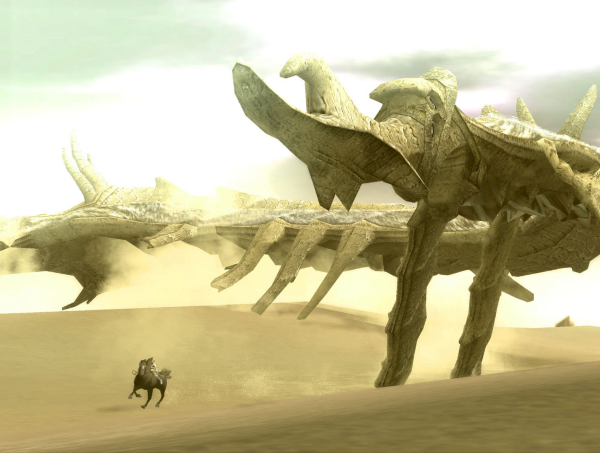
- It’s a bit like Bilbo’s sword Sting from the Hobbit, which used to glow when orcs were nearby. ↩
- If you wanted to extend the analogy you might say that there’s a couple of action figures in there too of completely different scales – a small one with a sword and a big one twenty times the size of the other. ↩
- I don’t know if anyone else has the same problem with this game that I always have, which is that you have to be stood in a very specific point next to the horse in order to climb on, otherwise Wander leaps upwards into the air like a complete maniac. ↩
Post by Sean Patrick Payne+ | December 7, 2014 at 3:53 pm | Game Guides for Non-Gamers, Video Games | No comment
Tags: Argo, Ico, puzzle games, Shadow of the Colossus, Team Ico, Wander
